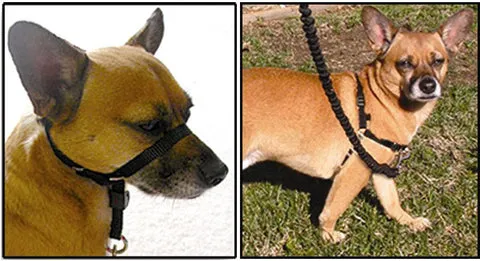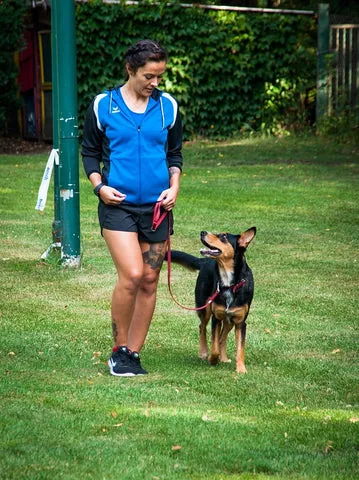Walking your dog should be an enjoyable experience for both of you, a peaceful stroll where your canine companion happily trots by your side. However, the reality for many dog owners is often a strenuous tug-of-war, with their dog pulling relentlessly on the leash. If you’re wondering how to get your dog not to pull on the leash, you’re not alone. Leash training can be one of the most challenging, yet rewarding, aspects of dog ownership. With patience, consistency, and the right techniques, you can transform your walks into a harmonious outing. This guide will walk you through effective strategies to teach your dog polite leash manners, making your vision of effortless walks a reality.
Essential Tools and Preparations Before Leash Training
While training is key, the right equipment can significantly aid in discouraging your dog from pulling. A head collar or a front-attachment harness are excellent no-pull devices that can provide more control and make the training process easier and safer for both you and your dog.
A front-attachment harness is generally safe and easy to use for all dogs. It works by redirecting your dog’s forward momentum to the side when they pull, making it physically harder for them to drag you along. For dogs with aggressive tendencies or for owners who require maximum control, such as a small person handling a giant-breed dog, a head collar can be particularly effective. It allows you to gently guide your dog’s head, and where the head goes, the body often follows.
It’s crucial that both the front-attachment harness and head collar are used with a leash that is a maximum of 6 feet long. A longer leash could allow your dog to build up too much speed, potentially causing injury if they abruptly hit the end of the leash. Additionally, ensure the equipment fits properly to prevent discomfort or escape.
 A small tan dog wears a head collar on the left and a front-attachment harness on the right
A small tan dog wears a head collar on the left and a front-attachment harness on the right
Before you begin training, consider your dog’s motivation. High-value treats, such as small pieces of fresh meat or cheese, are often excellent motivators. A treat bag worn around your waist can be incredibly helpful for quick access to rewards. If your dog isn’t particularly food-motivated, a favorite tug toy, chew toy, or a tossed ball can serve as a powerful alternative reward. Understanding what truly excites your dog will be a game-changer in their willingness to learn.
The “Stop and Reward” Method
A foundational method for teaching your dog not to pull on the leash is the “stop and reward” technique. The premise is simple: when your dog pulls, you stop moving. When they relax the leash and walk beside you, you reward them. This teaches your dog that pulling gets them nowhere, while polite walking earns them praise and treats. Consistency is vital here; every pull should result in a halt.
Step-by-Step Leash Training for a Dog That Pulls
The following steps provide a detailed guide on how to train a dog to walk on a leash politely, transforming those challenging walks into enjoyable outings.
Step 1: Making Walking with You a Rewarding Experience
Begin your leash training in a familiar, low-distraction outdoor area, such as your backyard. Attach your dog to a long rope or leash (10-20 feet long, non-retractable) while they are wearing a standard harness. Have plenty of pea-sized, high-value treats ready.
First, decide which side you prefer your dog to walk on (traditionally, the left). You will deliver the treat reward right by your thigh on that chosen side. This helps your dog associate that specific side with positive reinforcement, encouraging them to stay close.
Walk briskly and randomly around your yard. Whenever your dog chooses to walk beside you, reward them with enthusiastic praise and a treat delivered next to your preferred thigh. If they continue walking politely, reward them for every few steps you take together. As they improve, you can gradually reduce the frequency of rewards. If your dog seems uninterested, try again later when they might be a bit hungrier. Practice this step until your dog stays beside you more often than not.
Step 2: Following Your Lead and Staying Connected
This step focuses on teaching your dog to pay attention to your movements and follow your direction. Start walking around your yard. When your dog wanders off, lags behind to sniff, or attempts to relieve themselves without your cue, say “let’s go” in an upbeat tone. For the first few times, you might also slap your thigh to ensure they notice you, then turn and walk away from them.
As soon as your dog catches up to you, reward them with praise and a treat at your preferred side. Continue to reward them every couple of steps if they maintain their position. If they catch up quickly, offer an extra reward for their prompt response.
If the leash becomes tight and your dog doesn’t respond to “let’s go,” stop walking and apply gentle, consistent leash pressure. This pressure serves as a reminder of your presence and makes ignoring you slightly uncomfortable, but it should never be used to forcefully pull your dog. Release the pressure and praise them as soon as they begin to move towards you. Once they catch up, reward them as before. Continue practicing until your dog consistently returns to your side after your “let’s go” cue.
Step 3: Teaching Controlled Sniffing and Potty Breaks
While on a leash, dogs need opportunities to sniff and relieve themselves. However, you can help them develop better manners by deciding when these activities occur. During your training sessions, approximately every five minutes, or at a time you would typically give a food reward, say something like “go sniff” and allow your dog to explore or go potty on the leash. This is a privilege or reward. If they pull on the leash during this “free time,” immediately say “let’s go” and walk in the opposite direction, effectively ending the sniff break.
When you’re ready to resume walking, simply say “let’s go” and continue your stroll. This teaches your dog that controlled sniffing and potty breaks are earned and that pulling will cut their privileges short.
Step 4: Mastering Leash Control with Shorter Leashes and Challenges
Once your dog consistently performs well in steps one through three, gradually introduce a shorter leash. Eventually, aim for a standard 6-foot leash.
Practice walking at varying speeds—extra fast or extra slow—and incorporate frequent stops and changes in direction. Reward your dog generously if they manage to stay by your side during these challenges. As they become more proficient in normal circumstances, you can gradually reduce the frequency of rewards for simply walking beside you. However, continue to reward them when they maintain their position during challenging maneuvers or when encountering distractions like other animals or people. This helps solidify their understanding and responsiveness in different situations.
Taking Leash Training to the Street
When you’re ready to move your training from the quiet backyard to your neighborhood streets, apply the same techniques you’ve been practicing. Be prepared for additional distractions such as friendly strangers, squirrels, and other dogs. Consider using a front-attachment harness or head collar for extra control in these more stimulating environments, and always bring your highest-value treats.
Say “let’s go” and begin walking. If your dog becomes distracted or pulls, calmly say “let’s go” and turn and walk in the opposite direction. Reward them with treats when they walk politely by your side. It’s especially important to offer extra treats when it’s extra difficult for your dog to pay attention to you due to distractions. And don’t forget to grant permission for “sniff breaks” to keep them engaged and satisfied.
 Woman walking attentive black and tan dog
Woman walking attentive black and tan dog
Challenging Your Dog During Leash Training
To further solidify your dog’s leash manners, introduce controlled challenges. Outfit your dog in a standard harness attached to a 6-foot leash. Hold the leash and toss a ball or treat about 20 feet away from you and your leashed dog.
If your dog pulls towards the object, say “let’s go” and immediately turn and walk in the opposite direction. If they walk politely beside you as you approach the object, allow them to continue towards it until they reach it and can take it as their reward. Initially, you might use a longer leash or a less desirable object to make this exercise easier for them, gradually increasing the difficulty as they improve.
Troubleshooting Common Leash Pulling Issues
Even with consistent training, you might encounter some common challenges. Here’s how to address them:
- Dog Crossing in Front of You: If your dog frequently cuts in front of you, stomp or shuffle your feet slightly to make your presence more obvious and encourage them to stay to your preferred side.
- Dog Lagging Behind: A dog that lags significantly might be frightened or not feeling well. In such cases, use plenty of encouragement and avoid pulling them along. If they are lagging to sniff or potty, simply keep walking, applying only gentle pressure on the leash. Remember to use lots of rewards when they walk with you.
- Alternating Between Walking Nicely and Pulling: If your dog seems to be alternating between good behavior and pulling after you’ve practiced these steps, stop rewarding them for simply coming back to you after a pull. Instead, focus on rewarding them for taking a larger number of consecutive steps by your side. This reinforces sustained good behavior rather than just correcting a pull. For puppies, it’s important to establish good habits early.
How to Train a Dog to Walk On a Leash and Heel
Heel training is a useful command for short periods when you need your dog to be very close and highly attentive to you, especially when passing distractions like other animals or people.
Begin practicing the “heel” command in your home, where distractions are minimal. Place a treat in your fist and allow your dog to sniff it. Say “let’s go” or “heel” and take a couple of steps, leading your dog along with the treat near your thigh. Praise and reward them with the treat when they follow your fist with their nose.
Next, practice having your dog follow your empty fist. Continue to praise and reward them for every couple of steps they follow your hand signal. Gradually increase your standards with each session, expecting longer periods of heeling. Your closed fist will serve as the consistent hand signal for “heel.” Once proficient indoors, try practicing outside and in increasingly distracting circumstances. Training a puppy to be alone can also contribute to their overall discipline, making leash training easier.
By consistently applying these techniques, you can enjoy more relaxed and rewarding walks with your dog. Remember, patience and positive reinforcement are your most powerful tools in shaping your dog’s behavior. Happy walking!
